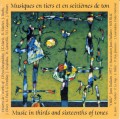Since DISCoveries began in the summer of 2001 we have reviewed 3,300 CDs and DVDs in these pages, including literally hundreds of local and independent releases. The section has evolved over the past nine years from modest beginnings with a handful of writers reviewing 14 discs in our first issue to about twenty regular contributors, including mavens Bruce Surtees, Geoff Chapman, Terry Robbins and Ken Waxman with their wealth of experience and diversity of expertise, covering more than three dozen titles each month in recent years.
A quick check of my data base reveals Canadian classical labels have been very well represented by DISCoveries, with two Montreal companies leading the pack - ATMA (168) and Analekta (108) – followed by National contributors CBC Records (94) and the Canadian Music Centre’s Centrediscs (82) and the Toronto company Marquis Classics (42). Smaller classical and contemporary Canadian labels include archival specialists DoReMi (31), XXI-Records (24) Arktos (21), Empreintes digitales (20), Artifact (15), Opening Day (15), Skylark (12) and Phoenix (6). Canadian Jazz and improvised music labels are also found in abundance with Ambiances Magnétiques (39), Justin Time (31), ALMA (16), Sackville (14), Timely Manor (6) and local newcomer Barnyard Records (3). And this does not include more than 500 reviews of independent releases by mostly local and regional artists spanning all creative genres.
Of course we don’t ignore the “majors” and have featured countless reviews of Canadian and local artists on international labels big and small: The Artists of the Royal Conservatory (ARC Ensemble) on RCA; Measha Brueggergosman on DG; Angela Hewitt, Michael Schade, Marc André Hamelin and Gerald Finley on Hyperion; Denise Djokic on SONY; Diana Krall on Verve; James Ehnes on Chandos and Onyx; Jane Bunnett, Jesse Cook and the Saint Lawrence Quartet all on EMI; Louis Lortie on Chandos; Marie-Nicole Lemieux on Naïve; MC Maguire on innova; Molly Johnson on Universal; Naida Cole on DECCA; Les Violons du Roy on Dorian, and I Furiosi on Dorian Sono Luminus; plus dozens of Canadian groups and artists who have appeared on NAXOS in recent years (Joel Quarrington and Andrew Burashko, Robert Aitken, Amici, Aradia, Luc Beauséjour, Elora Festival Choir, Karina Gauvin, Mirage Quartet, New Music Concerts, Patrick Wedd, the Toronto Chamber Orchestra and the Toronto Wind Orchestra to name just a few).
As the world becomes more focused on internet services and digital downloading, we too are developing web-based features including additional new reviews, access to archival material, search functions, links to artists and “click through to purchase” options on our website. But for the moment our emphasis remains with the 30,000 copies of the magazine which are printed and distributed throughout the GTA each month. With that in mind we continue to give priority to Toronto and Canadian artists and labels and to international musicians who will be performing in the GTA in the coming months. Discs already under consideration for the June issue include Pepusch and Gay’s “Polly” – a sequel to The Beggar’s Opera which was suppressed at the time of composition for political reasons and later reworked by Samuel Arnold - performed by a host of local singers and the Aradia Ensemble under Kevin Mallon’s direction (NAXOS); Margaret Little’s “Senza Continuo” – works for solo viola da gamba by Saint-Colombe and Marin Marais among others (ATMA); The ARC Ensemble’s third CD “Two Roads to Exile” – featuring rarely heard chamber gems by Walter Braunfels and Adolf Busch (RCA); Volume 1 of the “Complete Choral Music of Julian Wachner” - the 10th CD by the Elora Festival Singers under Noel Edison (NAXOS); local blues singer Shakura S’Aida’s second album “Brown Sugar” (on Germany’s Ruf Records); Vancouver chamber choir Musica Intima’s latest with works by Raminsh, Schafer, Lang, Morlock, Healey, Ryan and Sharman (ATMA); and a new release by Toronto pianist Mary Kenedi featuring concertos by Bloch, Bartok and Easton (Echiquier) which will be launched at a concert on May 9 at Gallery 345. As you can see our commitment to local and Canadian talent continues to be a top priority.
 In closing there is one recording I would like to tell you about - a long-awaited 2 CD set which documents some interesting experiments with microtonal divisions of the octave. It would be easy to think that it was only with the advent of the computer that it became possible to accurately divide the traditional 12 semitone chromatic octave into smaller parts. But there was a Mexican composer, Julian Carrillo (1875-1965), who in the middle of the last century commissioned Sauter, a German piano company, to manufacture instruments tuned in thirds, fourths, fifths and so on up to fifteenths and sixteenths of tones. Montreal composer Bruce Mather used the proceeds of his 2000 Serge Garant Prize to purchase a replica of Carrillo’s sixteenths of tone piano which he donated to the Montréal Conservatoire. The SNE release Music in Thirds and Sixteenths of Tones (SNE-667-CD) includes works written for this intriguing instrument by Gilles Tremblay, Jacques Desjardins, Michel Gonneville, Vincent Olivier Gagnon and Mather himself among others. In all, the keyboard of the Carrillo instrument incorporates 96 divisions of the octave. That is to say that the 97 notes on the Carillo’s keyboard span just one octave from top to bottom. It is intriguing how each of the composers finds ways to use these tiny intervals to best advantage. At times there is a wash of sound which totally immerses the auditor and at other times an abrasive juxtaposition of notes which sound convincing, but not quite right. Perhaps the easiest to grasp is Desjardins’ clever reworking of the folksong Où va Pierrot? The simplicity of the folk melody is subverted by the extreme microtonal possibilities of this unique instrument, but in a most intriguing and compelling way. Mather combines the Carrillo piano with the infinite possibilities of the ondes Martenot, one of the first electronic instruments, which like the Theremin is capable of glissandi and miniscule gradations of the octave. Interestingly, Mather chooses to use the ondes Martenot to give the tonal centre in his etudes. The first disc also includes works composed for Carrillo’s piano in thirds of tones by Wyschnegradsky, Mather and Jean Étienne Marie performed by Martine Joste. Not for the faint of heart, but an exquisite adventure for those who feel that “Eight is NOT Enough”.
In closing there is one recording I would like to tell you about - a long-awaited 2 CD set which documents some interesting experiments with microtonal divisions of the octave. It would be easy to think that it was only with the advent of the computer that it became possible to accurately divide the traditional 12 semitone chromatic octave into smaller parts. But there was a Mexican composer, Julian Carrillo (1875-1965), who in the middle of the last century commissioned Sauter, a German piano company, to manufacture instruments tuned in thirds, fourths, fifths and so on up to fifteenths and sixteenths of tones. Montreal composer Bruce Mather used the proceeds of his 2000 Serge Garant Prize to purchase a replica of Carrillo’s sixteenths of tone piano which he donated to the Montréal Conservatoire. The SNE release Music in Thirds and Sixteenths of Tones (SNE-667-CD) includes works written for this intriguing instrument by Gilles Tremblay, Jacques Desjardins, Michel Gonneville, Vincent Olivier Gagnon and Mather himself among others. In all, the keyboard of the Carrillo instrument incorporates 96 divisions of the octave. That is to say that the 97 notes on the Carillo’s keyboard span just one octave from top to bottom. It is intriguing how each of the composers finds ways to use these tiny intervals to best advantage. At times there is a wash of sound which totally immerses the auditor and at other times an abrasive juxtaposition of notes which sound convincing, but not quite right. Perhaps the easiest to grasp is Desjardins’ clever reworking of the folksong Où va Pierrot? The simplicity of the folk melody is subverted by the extreme microtonal possibilities of this unique instrument, but in a most intriguing and compelling way. Mather combines the Carrillo piano with the infinite possibilities of the ondes Martenot, one of the first electronic instruments, which like the Theremin is capable of glissandi and miniscule gradations of the octave. Interestingly, Mather chooses to use the ondes Martenot to give the tonal centre in his etudes. The first disc also includes works composed for Carrillo’s piano in thirds of tones by Wyschnegradsky, Mather and Jean Étienne Marie performed by Martine Joste. Not for the faint of heart, but an exquisite adventure for those who feel that “Eight is NOT Enough”.
We welcome your feedback and invite submissions. CDs and comments should be sent to: The WholeNote, 503 – 720 Bathurst St. Toronto ON M5S 2R4.
David Olds, DISCoveries Editor
discoveries@thewholenote.com



